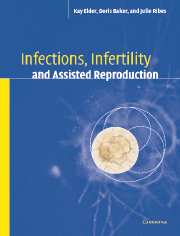Book contents
- Frontmatter
- Contents
- Foreword
- Preface
- Acknowledgements
- Part I Overview of microbiology
- Part II Infections in reproductive medicine
- Part III Infection and the assisted reproductive laboratory
- 13 Infection and contamination control in the ART laboratory
- 14 Handling infectious agents in the ART laboratory
- 15 Prevention: patient screening and the use of donor gametes
- Index
13 - Infection and contamination control in the ART laboratory
from Part III - Infection and the assisted reproductive laboratory
Published online by Cambridge University Press: 29 October 2009
- Frontmatter
- Contents
- Foreword
- Preface
- Acknowledgements
- Part I Overview of microbiology
- Part II Infections in reproductive medicine
- Part III Infection and the assisted reproductive laboratory
- 13 Infection and contamination control in the ART laboratory
- 14 Handling infectious agents in the ART laboratory
- 15 Prevention: patient screening and the use of donor gametes
- Index
Summary
Infection occurs when a susceptible part of the human body is exposed to a microorganism; this exposure may, or may not, lead to disease. Only the body, never the environment, is infected. Contamination may refer to the body (e.g. a wound can be contaminated), or to the working environment. Contamination occurs in the laboratory setting when a microorganism comes into contact with aseptic or sterile materials or supplies being handled or manipulated: contamination with environmental organisms has a negative impact on embryo culture. Gametes or embryos may be contaminated by exposure to organisms in the environment, exposure to pathogens found in body fluids of patients undergoing treatment, or from microorganisms carried by ART staff. When gametes or embryos are exposed to pathogenic organisms, there is the potential to transmit disease to several targets, including the developing embryo, the couple undergoing ART treatment, neighbouring gametes and embryos and subsequently other couples undergoing ART treatment, as well as ART health-care personnel. This unique situation, with multiple targets for contamination and infection, make infection and contamination control crucial in the ART laboratory.
Tissue culture systems used in the ART laboratory are designed to provide a physiological environment that can support and sustain cell metabolism and division, making them an ideal medium for the replication of a variety of microorganisms.
- Type
- Chapter
- Information
- Infections, Infertility, and Assisted Reproduction , pp. 305 - 331Publisher: Cambridge University PressPrint publication year: 2004



